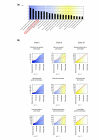New genes in the evolution of the neural crest differentiation program
- PMID: 17352807
- PMCID: PMC1868935
- DOI: 10.1186/gb-2007-8-3-r36
New genes in the evolution of the neural crest differentiation program
Abstract
Background: Development of the vertebrate head depends on the multipotency and migratory behavior of neural crest derivatives. This cell population is considered a vertebrate innovation and, accordingly, chordate ancestors lacked neural crest counterparts. The identification of neural crest specification genes expressed in the neural plate of basal chordates, in addition to the discovery of pigmented migratory cells in ascidians, has challenged this hypothesis. These new findings revive the debate on what is new and what is ancient in the genetic program that controls neural crest formation.
Results: To determine the origin of neural crest genes, we analyzed Phenotype Ontology annotations to select genes that control the development of this tissue. Using a sequential blast pipeline, we phylogenetically classified these genes, as well as those associated with other tissues, in order to define tissue-specific profiles of gene emergence. Of neural crest genes, 9% are vertebrate innovations. Our comparative analyses show that, among different tissues, the neural crest exhibits a particularly high rate of gene emergence during vertebrate evolution. A remarkable proportion of the new neural crest genes encode soluble ligands that control neural crest precursor specification into each cell lineage, including pigmented, neural, glial, and skeletal derivatives.
Conclusion: We propose that the evolution of the neural crest is linked not only to the recruitment of ancestral regulatory genes but also to the emergence of signaling peptides that control the increasingly complex lineage diversification of this plastic cell population.
Figures




Similar articles
-
[Phenotypic plasticity of neural crest-derived melanocytes and Schwann cells].Biol Aujourdhui. 2011;205(1):53-61. doi: 10.1051/jbio/2011008. Epub 2011 Apr 19. Biol Aujourdhui. 2011. PMID: 21501576 Review. French.
-
Central role of gene cooption in neural crest evolution.J Exp Zool B Mol Dev Evol. 2005 Jul 15;304(4):298-303. doi: 10.1002/jez.b.21047. J Exp Zool B Mol Dev Evol. 2005. PMID: 15880502 Review.
-
The evolutionary origin of the vertebrate neural crest and its developmental gene regulatory network--insights from amphioxus.Zoology (Jena). 2010 Jan;113(1):1-9. doi: 10.1016/j.zool.2009.06.001. Epub 2009 Nov 24. Zoology (Jena). 2010. PMID: 19939657 Review.
-
The evolution and elaboration of vertebrate neural crest cells.Curr Opin Genet Dev. 2008 Dec;18(6):536-43. doi: 10.1016/j.gde.2008.11.006. Epub 2009 Jan 2. Curr Opin Genet Dev. 2008. PMID: 19121930
-
Incremental evolution of the neural crest, neural crest cells and neural crest-derived skeletal tissues.J Anat. 2013 Jan;222(1):19-31. doi: 10.1111/j.1469-7580.2012.01495.x. Epub 2012 Mar 14. J Anat. 2013. PMID: 22414251 Free PMC article. Review.
Cited by
-
Evolution of the endothelin pathway drove neural crest cell diversification.Nature. 2020 Sep;585(7826):563-568. doi: 10.1038/s41586-020-2720-z. Epub 2020 Sep 16. Nature. 2020. PMID: 32939088
-
The journey of a generation: advances and promises in the study of primordial germ cell migration.Development. 2024 Apr 1;151(7):dev201102. doi: 10.1242/dev.201102. Epub 2024 Apr 12. Development. 2024. PMID: 38607588 Free PMC article.
-
Insights from the amphioxus genome on the origin of vertebrate neural crest.Genome Res. 2008 Jul;18(7):1127-32. doi: 10.1101/gr.076208.108. Epub 2008 Jun 18. Genome Res. 2008. PMID: 18562679 Free PMC article.
-
NK-like homeodomain proteins activate NOTCH3-signaling in leukemic T-cells.BMC Cancer. 2009 Oct 19;9:371. doi: 10.1186/1471-2407-9-371. BMC Cancer. 2009. PMID: 19835636 Free PMC article.
-
Genetic and developmental origins of a unique foraging adaptation in a Lake Malawi cichlid genus.Proc Natl Acad Sci U S A. 2018 Jul 3;115(27):7063-7068. doi: 10.1073/pnas.1719798115. Epub 2018 Jun 18. Proc Natl Acad Sci U S A. 2018. PMID: 29915062 Free PMC article.
References
Publication types
MeSH terms
Substances
LinkOut - more resources
Full Text Sources
Medical
Research Materials

